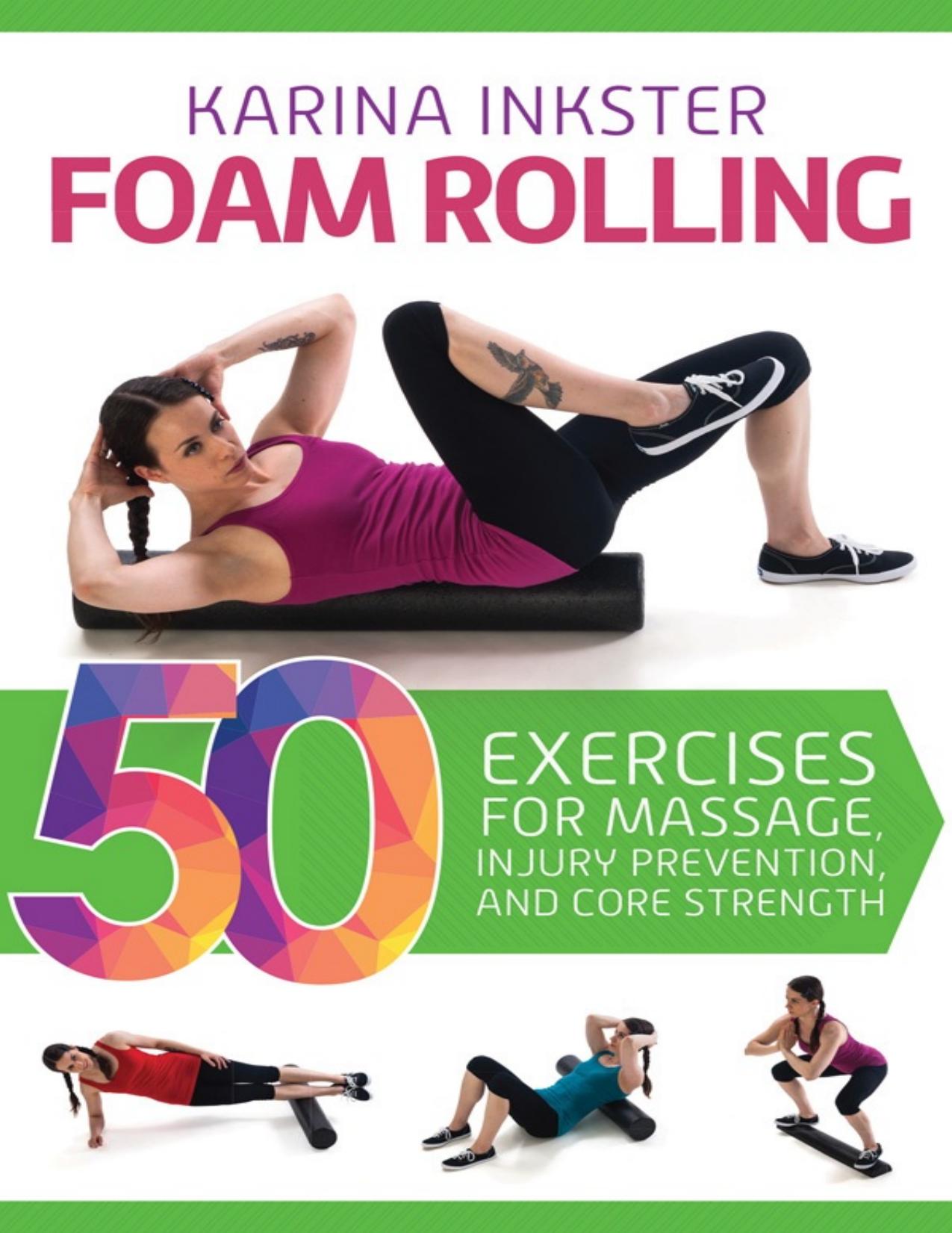Foam Rolling by Karina Inkster

Author:Karina Inkster
Language: eng
Format: epub, pdf
Publisher: Skyhorse Publishing
Published: 2014-12-31T16:00:00+00:00
CHAPTER 5:
FOAM ROLLER EXERCISES
The exercises in this book are grouped into three sections: Self-Myofascial Release, Flexibility and Mobility, and Strength and Core Stability. Based on your health and fitness goals, you may draw upon exercises from all three categories, or you may need to focus on one category in particular.
Self-myofascial release is the most common use for foam rolling, whereby you slowly roll along various muscle groups to release tension and muscle “knots.” The Flexibility and Mobility section is comprised of exercises that will increase the range of motion of your muscles (flexibility), and improve the ability of your muscles and joints to move through a range of motion with no restrictions (mobility). Exercises in the Strength and Core Stability section work to improve the strength of muscles throughout the body, with a special focus on core strength. Because the foam roller provides an unstable surface, your core muscles will need to work to keep your body stable during movement (the definition of core stability). A stable core is important for everything from preventing injury and low back pain, to performing your best during athletic activity, to having correct posture and spinal alignment.
FLEXIBILITY & MOBILITY
Increasing your flexibility and mobility is one of the cornerstones of any fitness program. You’ll be able to perform physical movements with a lower risk of injury and a greater range of motion. Some exercises in this section are static, or non-movement based, while others are dynamic and include movement. Make sure you ease slowly into each stretch, avoiding any “bouncing” movements, which can lead to injury.
Chest
Tight pectoral (chest) muscles are common in people with sedentary jobs. When this muscle group becomes too tight, it can pull the shoulders forward, leading to potential shoulder injuries and a forward slumped appearance. This position on the foam roller stretches the pectoral muscles to help return them to normal function.
Lie lengthwise on the foam roller with your tailbone at one end and your head at the other. Bend your knees and place your feet flat on the floor. Straighten your arms and bring them to 90 degrees from your body, palms facing the ceiling. Rest your arms on the floor and relax your chest and shoulder muscles.
Download
This site does not store any files on its server. We only index and link to content provided by other sites. Please contact the content providers to delete copyright contents if any and email us, we'll remove relevant links or contents immediately.
Tools of Titans by Timothy Ferriss(7812)
Bodyweight Strength Training by Jay Cardiello(7674)
Born to Run: by Christopher McDougall(6893)
Inner Engineering: A Yogi's Guide to Joy by Sadhguru(6440)
Asking the Right Questions: A Guide to Critical Thinking by M. Neil Browne & Stuart M. Keeley(5355)
The Fat Loss Plan by Joe Wicks(4619)
Bodyweight Strength Training Anatomy by Bret Contreras(4464)
Yoga Anatomy by Kaminoff Leslie(4100)
Science and Development of Muscle Hypertrophy by Brad Schoenfeld(3970)
Dynamic Alignment Through Imagery by Eric Franklin(3919)
ACSM's Complete Guide to Fitness & Health by ACSM(3823)
The Four-Pack Revolution by Chael Sonnen & Ryan Parsons(3791)
Exercise Technique Manual for Resistance Training by National Strength & Conditioning Association(3786)
Bodyweight Strength Training: 12 Weeks to Build Muscle and Burn Fat by Jay Cardiello(3779)
Yoga Anatomy by Leslie Kaminoff & Amy Matthews(3737)
The Ultimate Bodybuilding Cookbook by Kendall Lou Schmidt(3706)
Yoga Therapy by Mark Stephens(3569)
Nutrition for Sport, Exercise, and Health by Spano Marie & Kruskall Laura & Thomas D. Travis(3556)
Nutrition for Sport, Exercise, and Health by Marie Spano & Laura Kruskall & D. Travis Thomas(3546)
